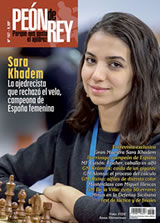Grau's chess performance
The Prologue
- 1. Rules of the game and preliminary notions
The chess. Its Nature and Its End
The board
Position of the board
The pieces
Placement of parts
Movement of parts
Limitation and modification of movement of parts
How the pieces are taken
Check
Kill him
The game tables
Two extraordinary moves
Rhythm of play
Nomenclature
Algebraic system
Descriptive system
To understand foreign language entries
Common vocabulary
- 2. Chess and its organ
Distinction Between Immediate and Medium Vision
Mastery of immediate vision
Development of the median vision of the game
Two exemplary types of chess reasoning: combination and celada
Common vocabulary
100 instruction items
Examples of matte combinations
- 3. Medium vision errors
The Errors of Medium Vision
Extraordinary resources for making tables
Exceptional resources to win
Other errors
- General remarks on the attack
Attacks on the King Without Rocking
Attacks on the Rocked King
More about opening games
- 5. Of gain and loss of material
The Importance
The value of the pieces
Of immediate material gain
Of the median material gain
The doubles
The locked rooms
The Discoveries
The nail and the bra
Forcing the handover
Solutions
Index of players
Index of complete items
The Prologue
- 1. Basic themes of combination
Material against time
Time against material
Attacks on the castle
The sacrifice
Long against short
Importance of peon formation
Space advantage and its derivative in attack
The dominance of the center, the basis of all offense
Attacks on point 'f7' and ('f2')
Two combined monuments: Evergreen and the Immortal
- Typical combination themes
Mates of bison and turtle
The matching points of the aggressor parts
Mates where bishops and horses gravitate
Combinations based on two horses and mates with two bishops
The domain of column 'h' on the casting
The mates in the eighth row
The bishop on the great diagonal
Typical mates at point 'h7' and ('h2')
The sacrifice in "h7" ("h2"), basis of the aggression
The sacrifice to extract the king
The king besieged as a matte base
The sacrifice to isolate the king
The domain of diagonals
Initiative, the basis of chess
Advanced pawns in 6th or 7th as attack subjects
The pawn, pivot over the king
Nailed" as a Matte Theme
Overloaded parts as combination subject
Unsupported parts
Abandoned piece, half lost piece
The lack of development and its important gravity in the attack
The lack of harmony between the pieces
The false development of parts
The dual threat as an indirect resource
Double threat and double check
The subtleties of "time" as a combining element
The relative value of the parts
How combinations are projected
The Dangers of Mistakes in Combinations
How to reason in chess
Difference Between Master and Amateur
The transposition of moves and its enormous importance
The real difficulty: tactical maneuvers
- 3. Tactical issues
Double check as a tactical theme
Why Double Checkers Occur
Double in finals composed of high hierarchy
The double check in the live game
The doubles experience in major tournaments
Tactical resources
How tactics and strategy are identified
Tactics are the basis of chess
The tactical art of Nimzovich
Tactics as a Lifesaver
The nail
Nailing and time saving
How the spikes are germinated in the open columns
The obstruction
Obstruction as a Tactical Resource
Obstruction and its ramifications
Obstruction as a strategic theme
Obstruction at plantations a key issue
Error as a vital force in chess
Difference between error and the bluff
Index of players
Index of complete items
The Prologue
Parts one and two:
- Typical shapes
The workers, the basis of the plans
The pawns and the value of the pieces
Pawn advancing, weakness in germ
Good workers for lost time
Bitter controversy between a theorist and a strategist
Also in chess everything is relative
Advantages and disadvantages of the double pawn
Typical skeletons of bent pawns
The pawns in column "c"
The pawn "f" bent
Compensation of bent central workers
Isolated and center-folded pawns
Center pawn bent and tied
Pawn folded in column 'd"
General conclusions
- 2. Forward workers
Tempting, but often unwise, maneuvers
Weakness of pawns in 5a (4a) held by pieces
Space advantage in exchange for vulnerable pawn
Be wary of dogma
General conclusions
- The past pawns
The past pawn begets chains of pawns
Conditions for a past pawn
Weak past workers
Pros and cons of the past pawn
Logic, the Basis of Reasoning
Technical conclusions
- 4. Capture of central isolated workers
The relative of an advantage pawn if it is isolated and fixed
The sacrifice of the isolated center pawn
The Sacrifice of Liberation
General conclusions
- 5. The force of lateral aggression of pawns
Disunity of central pawns by delivery of a pawn
The typical pawn sacrifice to achieve strengths
Conclusions
- The superiority of pawns on the enemy king's far flank
Advantages and risks of imposing superiority on one flank
The superiority of pawns on the king's wing
Conclusions
- The crowning of pawns as a combination theme
An exciting problem
The crowning of pawns as a tactical problem
Promotion of peons and their varieties
The crowning at the finals of bishops of different colors
The Sacrifice to Crown
As is sometimes the case in chess, modern ambition
Conclusions
Part two: Basic principles
- 8. Strategic plans at the plant
Irreconcilable key moves
The secret of planting strategy
The move ...e5 collides with the move ...c6
The advance h3 is doubtful conjugated with f4
The issue among the great masters
Conclusions
- Premature development of the lady
The problem of plantations
The dangerous temptation of the defenseless pawn "b
Principles to Consider
- Changing a smaller piece for three pawns
Is it really worth three pawns a horse, in the pantheons
The positional delivery of a piece by three pawns
Technical conclusions
- The strategic sacrifice of quality
Quality sacrifice, tactical weapon of several chess players
Sacrificing quality to pass workers
Alekhine's famous conclusions on the subject
Technical conclusions
- 12. The different value of the moves
Variable value of moves
The precautionary moves
- 13. Another delicious chess paradox: the zugzwang
Conclusions
- 14. False logic in chess
The illogical moves in the proposals
The Danger of "Natural" Moves"
The logic of an anti-routine approach
Nor should logic be confused with routine
Summary of the topic
Index of players
Index of complete items
The Prologue
- 1. The transformation of threats
How Threats Are Intertwined
The matching points of the parts
Linked boxes
The threat network
- 2. Battle of the bishop against the horse
Some basic rules
The bishop is superior in the positions of mobile pawn chains
The horses are superior in blocking positions
When the bishop is superior
What we already know
The bishop's advantage in open positions
Technical conclusions
- 3. The fight of horse with bishop with pawn advantage
With only one pawn on the board it's almost always boards
Some theoretical endings as exercises
The bishop almost always wins with pawn advantage
Ends with advantage in a famous example
Technical conclusions
- The advantage of two bishops over two horses or horse and bishop
Only in the blocking positions are the horses superior
Two bishops and bishop and horse
Why We Preach
The secret of simplification
General conclusions
- 5. Why must the lady bishop be locked up with the black
The bishop is usually "bad" outside the chain of pawns
The queen bishop and the theory of openings
The experience of modern approaches
Technical conclusions
- 6. The different-colored bison
The theory of Philidor
Coordination of pieces is vital in chess
The advantage of having a game and a tower
Conclusions
- The fight of the column "f" against the strong point "e4" (or "e5")
Subject of known plants
The open column must not be fully released
The relative importance of statements
The rook in the strong box of "e4" ("e5")
Point 'd4' ('d5') against column 'c"
Strong boxes: central part
Conclusions
- 8. The centralization of the lady
The skeleton of pawns, axis of chess
The difficulties of centralizing the lady
A centralised horse is usually worth more than a quality
Summary of the study
What we already know
Summary of examples
Conclusions
- Two towers against queen
Two towers are stronger than a lady
It's harder to drive the two towers than the lady
The strength of the two towers
Only mistakes really teach
As a warning
Technical conclusions
- The Changes of Ladies
The Danger of Routine
Some Valuable Rules
Conclusions
- 11. Towers and pawn ends
The advantage of the initiative
The abuse of draws to avoid risks
Summary of the study
Endgame experience
Why the Ends Are Unknown
The goal of the tower
It's not to generalize, but...
Other endgames with rook and pawns
General conclusions
Index of players
Index of items










